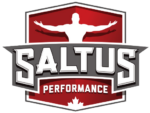One of our mandates at Saltus is to innovate, and we view flywheel based equipment as an important tool that will improve a person’s ability to develop strength, power, speed, resiliency, and movement patterns.
This page serves to outline literature and information on how flywheel based equipment works, why it can be superior to traditional training methods, and why we have decided to base so much of our training programming on it.
Features of flywheel training:
-Eccentric overload (safely and effectively)
-Variable resistance
-Isoinertial resistance
-Less torque on the lower back
-Easy on the joints
Eccentric overload
The stronger you are eccentrically, the more potential you have to jump high, run fast, cut hard, and properly absorb impact in order to remain injury free. The catch is that it can be difficult and risky to improve your eccentric strength with traditional training methods.
One of the most important advantages of the kBox and kPulley devices vs. other training methods, is the ability to achieve eccentric overload in a safe, practical, and effective way.
Please read more about what ‘eccentric’ means, and how you can achieve eccentric overload here.
Variable & Isointertial resistance
To develop muscle mass, you must have enough time under tension to fatigue the muscle fibres and produce the required hormones.
Variable resistance means that you can more easily work past the point of failure that would eventually arise when training with a static amount of resistance. This allows you to continue to fatigue the muscle fibres, where with other methods (such as barbell or dumbbell), you would need to stop the set or require extra planning to change the weight quickly.
Isointertial resistance means that you can exert maximal effort throughout the full range of motion of an exercise, whereas with other methods (such as barbell or dumbbell), you will be stronger in particular ranges of motion of an exercise while typically experiencing a sticking point in one portion of the range of motion. Without having the sticking point dictating the amount of force you can produce throughout your stronger ranges of motion, you can again use more resistance to trigger the development of strength and muscle mass beyond that of other training methods.
To learn more about variable resistance, isoinertial resistance, and other physiological benefits of flywheel training, click here.
Benefits for specific sports & populations
Follow these links to learn see the science and practical examples of flywheel training, as well as which famous athletes and professional sports teams are already adopting this up and coming technology.
Basketball
Running
Endurance sports
Volleyball
Soccer
Baseball
Skiing
Youth
**More sports listed here**
